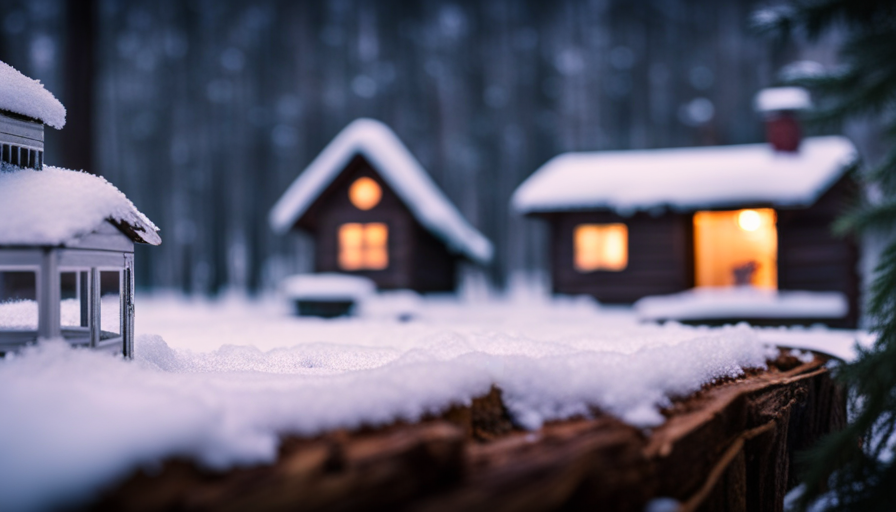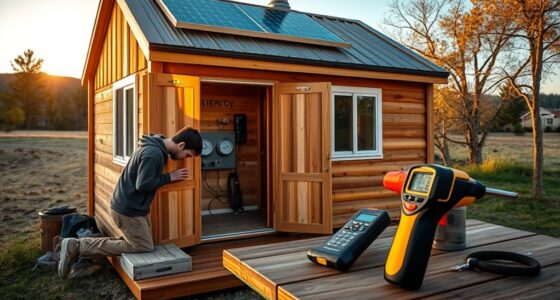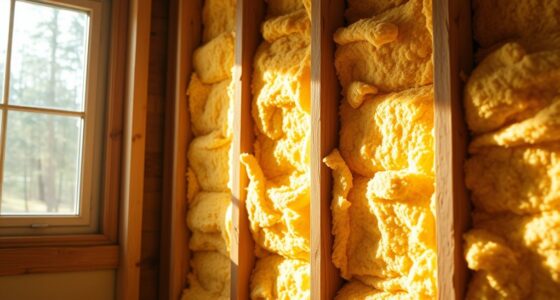Stepping outside, the icy wind penetrates through me, reminding me of the harsh reality of living in a cold environment. However, as I approach my humble abode, a warm smile spreads across my face.
You see, I’ve discovered the best tiny homes for cold climates, and they have completely transformed my experience of winter living. These tiny homes are not only efficient in their insulation, but they also offer space-saving solutions that make cozy living a reality. With innovative design features specifically tailored for cold climates, these homes prioritize sustainability, ensuring that our footprint on the environment remains minimal.
And when it comes to heating solutions, these tiny homes have it all figured out. From efficient wood-burning stoves to radiant floor heating, staying warm and toasty is never an issue.
But it’s not just about functionality; these homes also boast beautiful interior designs that create a sense of comfort and serenity. So, whether you long for a cozy cabin nestled in the snow-capped mountains or a contemporary oasis amidst the winter wonderland, these tiny homes have got you covered.
Join me as we explore the best tiny homes for cold climates, and discover a whole new world of sustainable, cozy living.
Key Takeaways
- Sustainable and efficient insulation is crucial for tiny homes in cold climates.
- Heating solutions such as wood-burning stoves and radiant floor heating are commonly used.
- Proper insulation, energy-efficient windows, and insulation film are important for warmth.
- Cozy interior design ideas using natural elements and rich colors create a cozy ambiance.
Efficient Insulation for Cold Weather
If you want to freeze your buns off, go ahead and skip the efficient insulation when building a tiny home for cold climates. Trust me, it’s not worth it.
When it comes to keeping your tiny home warm in chilly weather, energy efficient windows and proper insulation are key. Opt for windows with multiple panes and low-emissivity coatings to minimize heat loss.
Additionally, insulating flooring options like cork or rigid foam can help prevent cold air from seeping in through the floor. These materials have excellent thermal resistance properties and provide a cozy feel underfoot.
Now, let’s move on to space-saving solutions for cozy living, because who doesn’t want to maximize their tiny home’s functionality without sacrificing comfort?
Space-Saving Solutions for Cozy Living
Imagine living in a compact yet efficient dwelling designed to maximize every square inch for your cozy comfort. When it comes to tiny homes in cold climates, space-saving solutions are essential.
One of the key aspects to consider is the use of space-saving furniture. Multipurpose pieces, such as foldable tables and beds with built-in storage, can help maximize the functionality of each room.
Additionally, creative storage solutions are crucial to keep your tiny home organized and clutter-free. Utilizing vertical space with wall-mounted shelves and using storage ottomans or benches can provide extra storage without taking up valuable floor space.
These space-saving strategies not only make your tiny home feel more spacious, but they also contribute to a sustainable lifestyle by encouraging minimalism and reducing waste.
Transitioning into the next section on innovative design features, we discover that these space-saving solutions are just the beginning of creating the perfect tiny home for cold climates.
Innovative Design Features for Cold Climates
Living in a compact dwelling in chilly weather might require some clever design elements to ensure coziness without compromising on style. One innovative design feature for cold climates is the use of passive solar heating. This technique harnesses the power of the sun to naturally warm the interior of the tiny home. By strategically placing windows and utilizing thermal mass materials, such as concrete or stone, the home can absorb and store heat during the day and release it at night.
Another important aspect of cold weather design is the use of energy-efficient windows. These windows are designed to minimize heat loss and maximize insulation, helping to keep the interior of the tiny home warm and cozy.
Incorporating these design features not only creates a comfortable living environment, but also reduces the reliance on artificial heating methods, making it a sustainable choice for cold weather living.
Transitioning into the next section on sustainability, it is important to consider other factors such as insulation and renewable energy sources.
Sustainability in Cold Weather Living
To ensure a sustainable living environment in chilly weather, you should prioritize insulation and renewable energy sources. Here are some key considerations for sustainability in cold weather living:
- Energy Efficient Appliances: Investing in energy-efficient appliances can significantly reduce your energy consumption. Look for appliances with high energy star ratings and consider options like solar-powered refrigerators and LED lighting.
- Off-Grid Living: Embracing off-grid living allows you to be self-sufficient and reduce your reliance on traditional energy sources. Incorporate solar panels, wind turbines, and rainwater harvesting systems to power your tiny home and conserve resources.
- Insulation: Proper insulation is crucial in cold climates to minimize heat loss and maintain a comfortable temperature inside your tiny home. Opt for high-quality insulation materials like spray foam or cellulose insulation to create a well-insulated and energy-efficient living space.
- Passive Design: Incorporate passive design principles into your tiny home, such as strategically placing windows to maximize natural light and heat gain during the winter months.
Transitioning into the subsequent section about heating solutions for tiny homes in cold climates, it’s essential to explore efficient ways to keep your tiny home warm and cozy.
Heating Solutions for Tiny Homes in Cold Climates
You can easily achieve a warm and cozy environment in your compact abode during chilly weather by exploring efficient heating solutions.
One option is to utilize energy-efficient heaters, which can reduce energy consumption by up to 50%. When it comes to heating, you have the choice between electric and propane options.
Electric heaters are convenient and easy to use, but they can be costly to run. On the other hand, propane heaters are more affordable to operate, but they require a propane tank and regular refills.
Another sustainable option to consider is solar-powered heating. By harnessing the power of the sun, you can heat your tiny home while minimizing your carbon footprint.
As we move into the next section on winterizing your tiny home, it’s essential to ensure your heating system is properly maintained and optimized for efficiency.
Winterizing Your Tiny Home
If you thought your compact dwelling was cozy before, just wait until you witness the winter wonderland transformation of your tiny home. Winterizing your tiny home is crucial to ensure comfort and energy efficiency during the cold months.
One important aspect of winterizing is insulating windows to prevent heat loss and drafts. Here are some tips to help you with this task:
- Install weatherstripping around windows and doors to seal any gaps.
- Use window insulation film to create an additional barrier against cold air.
- Hang thermal curtains or blinds to provide extra insulation.
By taking these steps, you can significantly reduce heat loss and keep your tiny home warm and snug during the winter.
In the next section, we’ll explore the importance of choosing the right materials for cold weather, which is another essential aspect of preparing your tiny home for the winter months.
Choosing the Right Materials for Cold Weather
Prepare for the winter months by selecting materials that are specifically designed to withstand cold weather conditions. When it comes to insulation options for tiny homes, there are a few cost-effective materials that can help keep you warm.
One option is spray foam insulation, which creates an airtight seal and provides excellent thermal resistance. Another option is rigid foam insulation, which is easy to install and has a high R-value. Additionally, using double-pane windows with low-emissivity coatings can help prevent heat loss.
When choosing materials for your tiny home, it’s important to consider their environmental impact as well. Look for materials that are sustainable and have a low carbon footprint.
As we move on to the next section about snow management tips for tiny home owners, it’s crucial to remember that proper insulation and material selection can also play a role in preventing snow buildup on your roof.
Snow Management Tips for Tiny Home Owners
When it comes to living in a cold climate, snow management becomes a crucial part of maintaining a tiny home. After choosing the right materials for cold weather, it is important for tiny home owners to be prepared for snow removal and winter maintenance. Snow can accumulate quickly and cause damage to the structure if not properly managed. To help with this, here are some snow management tips for tiny home owners:
- Clear the roof regularly to prevent excess weight and potential leaks.
- Shovel pathways and stairs to ensure safe access in and out of the home.
- Use salt or sand to prevent slippery surfaces around the tiny home.
- Insulate pipes and water sources to prevent freezing.
By following these snow management tips, tiny home owners can ensure the longevity and functionality of their homes throughout the winter months. Now, let’s explore the next topic: cold climate tiny home communities.
Cold Climate Tiny Home Communities
Joining a community of like-minded individuals in a snowy landscape offers the opportunity to embrace the winter wonderland and create lasting connections. An average of 150 tiny home owners come together to celebrate the beauty of the season.
Here are four reasons why living in a cold climate tiny home community is a great choice:
- Tiny home building regulations in these communities prioritize energy efficiency and insulation, ensuring that your home stays warm and comfortable during the cold winter months.
- The cost of living in these communities is often lower compared to traditional housing, allowing you to save money and live a more sustainable lifestyle.
- Living in a cold climate community means you’ll have access to ample outdoor activities like skiing, snowshoeing, and ice fishing, making every day an adventure.
- These communities often foster a strong sense of camaraderie and support among residents, creating a tight-knit community where everyone looks out for each other.
By joining a cold climate tiny home community, you can enjoy the benefits of living sustainably while being surrounded by nature’s beauty. Transitioning into the subsequent section, let’s explore some cozy interior design ideas for cold weather living.
Cozy Interior Design Ideas for Cold Weather Living
Embrace the warmth and comfort of your cozy winter retreat with these interior design ideas for creating a snug and inviting space.
When it comes to winter decor, consider using natural elements like wood and wool to add warmth and texture to your tiny home.
Opt for rich, deep colors like burgundy, navy, or forest green to create a cozy ambiance.
To make your space even more inviting, invest in a fireplace. There are various fireplace options available for tiny homes, such as electric or propane fireplaces, which provide both heat and a cozy, flickering flame.
You can also consider a compact wood-burning stove if you have access to firewood. Just be sure to follow safety guidelines and consider the environmental impact.
With these interior design ideas, you can create a cozy haven that’ll keep you warm all winter long.
Frequently Asked Questions
What are the best types of insulation for tiny homes in cold climates?
The best types of insulation for tiny homes in cold climates are those that provide excellent thermal performance and energy efficiency. Some options include spray foam insulation, which creates an airtight seal and prevents heat loss.
Another option is cellulose insulation, made from recycled materials and providing excellent insulation properties.
Additionally, insulated concrete forms (ICFs) offer high energy efficiency and can help regulate temperature in cold climates.
These insulation choices help reduce energy consumption and maintain a comfortable living environment.
How can I maximize space in a tiny home while still maintaining a cozy atmosphere?
To maximize space in a tiny home while maintaining a cozy atmosphere, I focus on creating multifunctional spaces and maximizing storage.
Did you know that on average, we spend 40% of our living space on storage? By utilizing clever storage solutions like built-in cabinets, hidden compartments, and vertical shelving, I can make the most of every inch.
Additionally, I incorporate furniture that serves dual purposes, such as a sofa that doubles as a guest bed or a dining table that can be folded down when not in use. This approach not only saves space but also promotes sustainability by reducing the need for excess furniture and materials.
Are there any unique design features that are particularly beneficial for cold climates?
Passive solar design and energy-efficient windows are crucial design features for tiny homes in cold climates.
Passive solar design utilizes the sun’s energy to naturally heat the home, reducing the need for artificial heating. This can be achieved through strategic placement of windows and thermal mass materials.
Energy-efficient windows help to minimize heat loss and maximize insulation.
By incorporating these features, tiny homes can effectively combat the cold weather while minimizing energy consumption and promoting sustainability.
What are some sustainable practices that can be implemented in cold weather living?
Living in a cold climate requires sustainable practices to ensure comfort and minimize environmental impact.
One important aspect is sustainable energy, such as using solar panels or wind turbines to power the home.
Another practice is winter gardening, which involves growing vegetables indoors or in greenhouses to provide fresh food year-round.
These practices not only reduce our carbon footprint but also help us become more self-sufficient and resilient in cold weather living.
What are the most effective heating solutions for tiny homes in cold climates?
When it comes to heating solutions for tiny homes in cold climates, the key is to focus on heating system efficiency and alternative fuel options. It’s important to choose a heating system that is energy-efficient, such as a high-efficiency electric or propane furnace.
Additionally, considering alternative fuel options like biomass or pellet stoves can help reduce our environmental impact. By carefully selecting efficient heating systems and alternative fuel options, we can ensure comfortable living while being environmentally conscious.
Conclusion
Living in a tiny home in a cold climate may seem daunting, but with the right knowledge and design choices, it can be a cozy and sustainable experience. There are endless possibilities to create a warm and inviting space, from efficient insulation to innovative space-saving solutions. By choosing the right materials and implementing heating solutions, you can ensure that your tiny home stays snug even in the harshest winters. With a touch of creativity and a commitment to sustainability, your tiny home in a cold climate can become a haven of comfort and beauty.
I’m Theodore, and I love tiny houses. In fact, I’m the author of Tiny House 43, a book about tiny houses that are also tree houses. I think they’re magical places where imaginations can run wild and adventures are just waiting to happen.
While tree houses are often associated with childhood, they can be the perfect adult retreat. They offer a cozy space to relax and unwind, surrounded by nature. And since they’re typically built on stilts or raised platforms, they offer stunning views that traditional homes simply can’t match.
If you’re looking for a unique and romantic getaway, a tree house tiny house might just be the perfect option.










